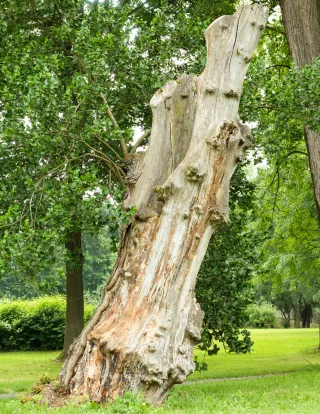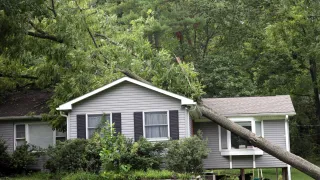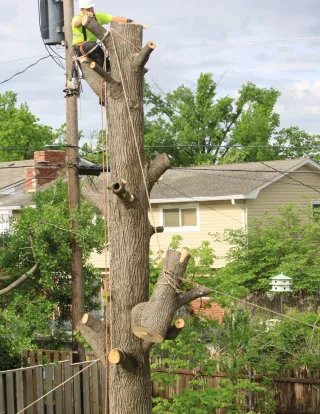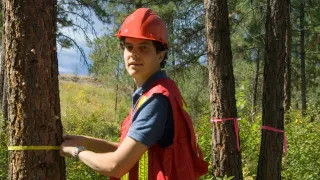
Preparing Your Property for Winter: A Tree Owner's Checklist
Winter in Tennessee can be unpredictable – mild one week, ice storm the next. Your trees need different preparation than they would further north or south, and the timing matters more than you might expect. I've seen too many preventable winter tree problems that could have been avoided with some basic preparation in fall.
Most winter tree damage isn't from extreme cold – it's from ice loading, wind, and sudden temperature swings that stressed or unprepared trees can't handle.
Assessment First: What You're Working With
Walk your property and look up – this is the time of year when tree structure is most visible as leaves drop.
Dead branches become obvious and need to come down before ice loading tests them. A branch that hangs on all summer will likely fail with the first significant ice accumulation.
Weak attachments – co-dominant stems, branches with included bark, or branches that show signs of splitting are winter failure risks.
Leaning trees or trees with root problems become more dangerous in winter weather when ice and wind add stress to already compromised structures.
Overhanging hazards – branches over houses, cars, walkways, or power lines that might not cause problems in calm weather become dangerous in winter storms.
Pruning for Winter: What to Remove
Dead, diseased, and damaged material should come off before winter. These branches will fail eventually, and winter weather often provides the stress that causes the failure.
Water sprouts and suckers that grew rapidly during the summer are usually weakly attached and vulnerable to wind and ice damage.
Crossed or rubbing branches that create wounds or weak points in the tree structure.
Branches with acute angles (narrow crotches) that are prone to splitting under ice or wind loads.
What NOT to prune: Don't do major structural pruning or size reduction in late fall. Save heavy pruning for dormant season when trees can handle the stress better.
Root Zone Winter Prep
Mulching helps moderate soil temperature and prevents freeze-thaw cycles that can damage shallow roots. 2-4 inches of organic mulch, keeping it away from tree trunks, provides good winter protection.
Watering – trees need water going into winter, especially if fall has been dry. Deep watering in late fall helps trees store moisture for winter, when water uptake is reduced but not eliminated.
Soil compaction should be addressed before ground freezes. Compacted soil prevents water infiltration and root growth, making trees more vulnerable to winter stress.
Drainage issues can become serious problems when freeze-thaw cycles create ice that blocks normal water movement.
Young Tree Protection
Newly planted trees (anything planted within the last 2-3 years) need extra winter protection because their root systems aren't fully established.
Tree wrapping may be beneficial for thin-barked species like maples, especially young ones, to prevent sun scald and frost cracking.
Staking should be checked – make sure stakes and ties aren't too tight or causing damage, but that trees that need support have adequate bracing for winter winds.
Mulching is especially important for young trees because their root systems are more vulnerable to temperature fluctuations.
Protecting Trees from Ice Damage
You can't prevent ice storms, but you can reduce their impact:
Remove branches that are already stressed or showing signs of weakness – these will fail under ice loading.
Prune to reduce sail area on branches that catch wind and ice – this doesn't mean topping, but selective thinning can reduce wind resistance.
Don't attempt to remove ice from trees during or immediately after ice storms – it's dangerous and often causes more damage than leaving it alone.
Plan for power outages that might result from tree failures during ice events.
Storm Preparation and Emergency Planning
Identify potential hazards before storms hit:
Trees or branches that could fall on structures
Trees that could block driveways or emergency access
Trees near power lines that could cause outages
Have emergency contacts ready – tree services, utility companies, insurance companies, and local emergency services.
Document tree conditions with photos if you're concerned about specific trees – this can be helpful for insurance claims if damage occurs.
Clear potential projectiles from around trees – lawn furniture, decorations, or other items that could become dangerous in high winds.
Evergreen Considerations
Evergreens face different winter challenges than deciduous trees:
Snow and ice loading can be heavier on evergreens because they retain their needles and collect more precipitation.
Winter desiccation affects evergreens when roots can't take up water from frozen soil but needles continue to lose moisture through transpiration.
Salt damage from road salt or ice treatment can be a problem for evergreens near driveways or roads.
Proper fall watering is especially important for evergreens going into winter.
What Homeowners Can Handle
Small dead branches that you can reach safely from the ground – use proper tools and don't overreach.
Mulching around tree bases – this is safe and beneficial if done properly.
Light pruning of small branches (under 2 inches diameter) that are obviously dead or damaged.
Watering – deep, slow watering in late fall if conditions have been dry.
What Requires Professional Help
Large branch removal or anything that requires ladders, chainsaws, or work near power lines.
Structural assessment of trees you're concerned about – experience matters in evaluating winter failure risks.
Work in difficult access areas or around buildings where falling debris could cause damage.
Emergency storm response – working around damaged trees and power lines requires specialized training and equipment.
Timing Matters
Early fall (September-October) is ideal for most winter preparation activities. Trees are beginning dormancy but haven't shut down completely.
Late fall (November) is still useful for final preparations, but major pruning should be finished earlier.
Don't wait until winter weather arrives – once ice or snow is forecast, it's too late for preventive work.
Plan ahead – tree services get busy with storm preparation and response, so early scheduling is important.
Cost vs. Benefit Analysis
Prevention is almost always cheaper than dealing with winter damage after it occurs.
Emergency tree work costs significantly more than planned maintenance.
Property damage from tree failure can be expensive and might not be fully covered by insurance if it's deemed a maintenance issue.
Investing in professional assessment for questionable trees can prevent much larger expenses later.
Regional Considerations for Tennessee
Ice storms are our biggest winter tree threat – more so than extreme cold or heavy snow.
Temperature swings can be dramatic and stress trees that aren't properly prepared.
Winter droughts are common and can weaken trees going into and coming out of dormancy.
Clay soils in much of the area have drainage issues that can become serious problems during freeze-thaw cycles.
Don't Forget About Spring
Winter preparation sets the stage for spring recovery. Trees that go into winter healthy and well-prepared bounce back faster in spring.
Document any winter damage as it occurs so you can address it promptly in spring when conditions are better for tree work.
Plan spring maintenance based on what you observe during winter – this helps you get ahead of problems before they become serious.
The Reality of Winter Weather
No preparation guarantees trees won't be damaged in severe weather, but good preparation reduces the likelihood and severity of damage.
Most winter tree problems are predictable – trees that were already stressed or had structural issues are the most likely to fail.
Emergency preparedness is as important as tree preparation – know what to do if trees do fail during winter storms.
The Bottom Line
Winter tree preparation is about reducing risks, not eliminating them. Good fall preparation significantly improves the chances that your trees will come through winter in good shape.
Focus on obvious hazards first – dead branches, weak attachments, and overhanging risks that could cause property damage or safety issues.
Professional assessment is valuable for large trees, complex situations, or when you're not sure about the risk level of specific trees.
Early action prevents emergency situations and saves money compared to dealing with storm damage after it occurs.
If you're looking at your trees and wondering what needs attention before winter, or if you want professional assessment of winter risks on your property, give us a call or text at (423) 443-4533. Getting ahead of winter tree issues is always easier and less expensive than dealing with emergency situations in bad weather.











